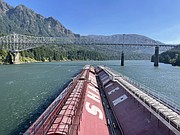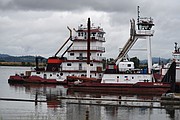Troy Moore: Only as good as his deckhands
THE DALLES — Roy Moore slowly and carefully adjusts both the rudders and the throttle on the tugboat Lincoln as he maneuvers into the lock at The Dalles Dam.
As pilot of Shaver Transportation’s tugboat Lincoln, he’s pushing four giant barges, each 42 feet wide, all over 200 feet long with the longest nearly 300 feet, lashed together and filled with 13,000 tons of wheat. The tow — that’s what he calls the whole assembly of barges and tugboat — just barely fits in the lock, and Moore listens intently to deckhand Sean Malloy as he calls out numbers.
“120 … 110 … 100,” Malloy said, telling Moore just how close the bow of the front left barge is from the long wall of the lock and how much space he has to port — the left side of the tow — so he can maneuver.
It’s something these inland sailors do at every dam lock and at every approach to a grain terminal. The tow is more than 600 feet long, and even five decks up in the Lincoln’s wheelhouse, Moore can’t easily see around the bow of the two front barges 500 feet in front of him.
“I can’t see nothing,” Moore said. “I can’t even see the wall.”
Moore very carefully pushed the tow into the lock. If he scraped or even touched either of the sides — and there’s only one foot of space to either side of the tow — you couldn’t feel it and you couldn’t hear it. Once in, Malloy and Colby Glaze, a midshipman from the California Maritime Academy in Vallejo working for a few weeks as a trainee with Shaver, secured the tow to a pair of floating metal bumpers attached to the wall of the lock.
The Lincoln is double crewed for this four-day trip from Central Ferry to Rainier, Oregon, with two pilots, two deckhands and one trainee, each rotation working a six-hour shift, though all hands are on deck for crucial operations like lock transits as well as picking up and delivering barges.
Thirty minutes and nearly 40 million gallons of water later, the Lincoln and its four barges — the first of which Moore and his crew of four picked up at the Pomeroy Grain Growers terminal in Central Ferry along the Snake River — descended over 80 feet to continue their journey down the Columbia River to Portland.
For Moore, the maneuver is proof of how important experienced deckhands are to a pilot.
“I’m only as good as my deckhands. A good deckhand will make a bad operator look good and a good operator look horrible,” Moore said.
Moore knows. He started out as a deckhand 22 years ago, tying ropes and winching cable. He’s worked the Snake and Columbia rivers most of his adult life. He worked his way up, getting the licenses he needed to pilot tugboats and haul a good portion of the millions of bushels of wheat grown and harvested every year in Eastern Washington and other portions of the Pacific Northwest to buyers in the U.S. and abroad, mostly in Asia.
Being a deckhand is physically demanding, Moore said and requires strength, dexterity and an ability to pay close attention to the work at hand, especially when securing the 1.5-inch diameter metal cables used to lash the barges together.
“That cable can make a young man old,” Moore said.
It’s also dangerous work, and several times Moore has to remind a trainee, as he lashes the tow to a bumper in a lock to stand back several feet from the rope after he ties it off, just in case it breaks. The tension in the rope is enough to cause serious injury.
“I’m not going to tell you again,” Moore spoke into the radio handset.
“Got it,” the trainee responded as he stepped back.
Moore let go of the handset and stood over the two pair of paddles that control the front and rear rudders.
“I’m going to tell him again,” he smiled.
Charles H. Featherstone can be reached at cfeatherstone@columbiabasinherald.com. Featherstone was recently able to accompany Moore and his crewmates on a trip down the Snake and Columbia rivers to explore how crops and products from the Columbia Basin travel to various markets. Look for more coverage of that trip coming up in the Columbia Basin Herald, Basin Business Journal and the Studio Basin podcast.







